AMD Zen 3 Ryzen Deep Dive Review: 5950X, 5900X, 5800X and 5600X Tested
by Dr. Ian Cutress on November 5, 2020 9:01 AM ESTCPU Tests: Simulation
Simulation and Science have a lot of overlap in the benchmarking world, however for this distinction we’re separating into two segments mostly based on the utility of the resulting data. The benchmarks that fall under Science have a distinct use for the data they output – in our Simulation section, these act more like synthetics but at some level are still trying to simulate a given environment.
DigiCortex v1.35: link
DigiCortex is a pet project for the visualization of neuron and synapse activity in the brain. The software comes with a variety of benchmark modes, and we take the small benchmark which runs a 32k neuron/1.8B synapse simulation, similar to a small slug.
The results on the output are given as a fraction of whether the system can simulate in real-time, so anything above a value of one is suitable for real-time work. The benchmark offers a 'no firing synapse' mode, which in essence detects DRAM and bus speed, however we take the firing mode which adds CPU work with every firing.
The software originally shipped with a benchmark that recorded the first few cycles and output a result. So while fast multi-threaded processors this made the benchmark last less than a few seconds, slow dual-core processors could be running for almost an hour. There is also the issue of DigiCortex starting with a base neuron/synapse map in ‘off mode’, giving a high result in the first few cycles as none of the nodes are currently active. We found that the performance settles down into a steady state after a while (when the model is actively in use), so we asked the author to allow for a ‘warm-up’ phase and for the benchmark to be the average over a second sample time.
For our test, we give the benchmark 20000 cycles to warm up and then take the data over the next 10000 cycles seconds for the test – on a modern processor this takes 30 seconds and 150 seconds respectively. This is then repeated a minimum of 10 times, with the first three results rejected. Results are shown as a multiple of real-time calculation.
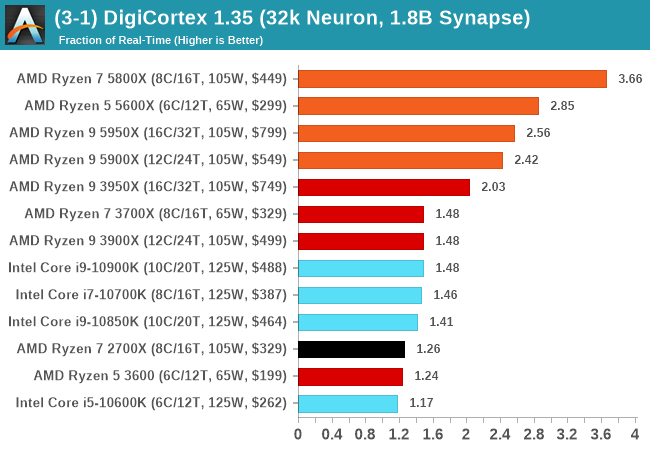
Dwarf Fortress 0.44.12: Link
Another long standing request for our benchmark suite has been Dwarf Fortress, a popular management/roguelike indie video game, first launched in 2006 and still being regularly updated today, aiming for a Steam launch sometime in the future.
Emulating the ASCII interfaces of old, this title is a rather complex beast, which can generate environments subject to millennia of rule, famous faces, peasants, and key historical figures and events. The further you get into the game, depending on the size of the world, the slower it becomes as it has to simulate more famous people, more world events, and the natural way that humanoid creatures take over an environment. Like some kind of virus.
For our test we’re using DFMark. DFMark is a benchmark built by vorsgren on the Bay12Forums that gives two different modes built on DFHack: world generation and embark. These tests can be configured, but range anywhere from 3 minutes to several hours. After analyzing the test, we ended up going for three different world generation sizes:
- Small, a 65x65 world with 250 years, 10 civilizations and 4 megabeasts
- Medium, a 127x127 world with 550 years, 10 civilizations and 4 megabeasts
- Large, a 257x257 world with 550 years, 40 civilizations and 10 megabeasts
DFMark outputs the time to run any given test, so this is what we use for the output. We loop the small test for as many times possible in 10 minutes, the medium test for as many times in 30 minutes, and the large test for as many times in an hour.
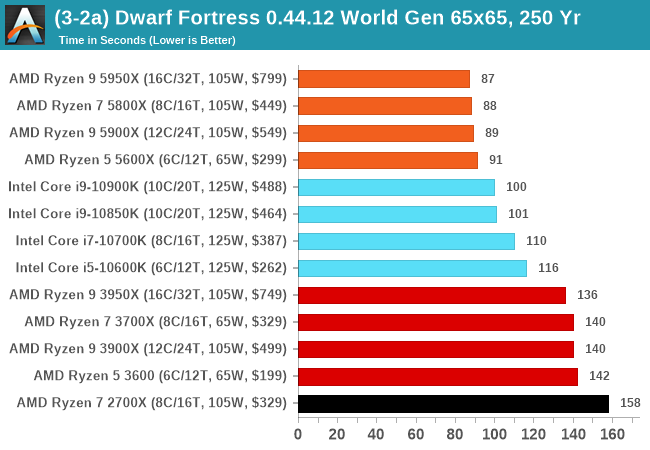
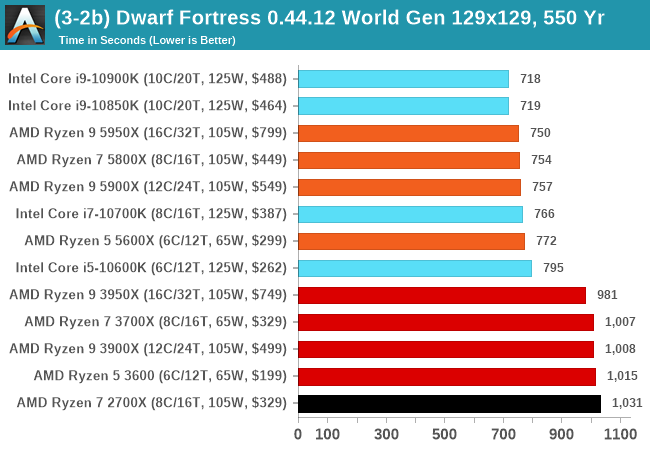
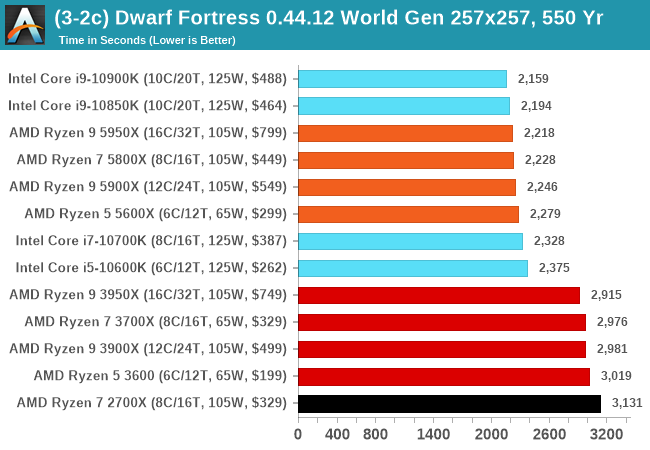
Dolphin v5.0 Emulation: Link
Many emulators are often bound by single thread CPU performance, and general reports tended to suggest that Haswell provided a significant boost to emulator performance. This benchmark runs a Wii program that ray traces a complex 3D scene inside the Dolphin Wii emulator. Performance on this benchmark is a good proxy of the speed of Dolphin CPU emulation, which is an intensive single core task using most aspects of a CPU. Results are given in seconds, where the Wii itself scores 1051 seconds.
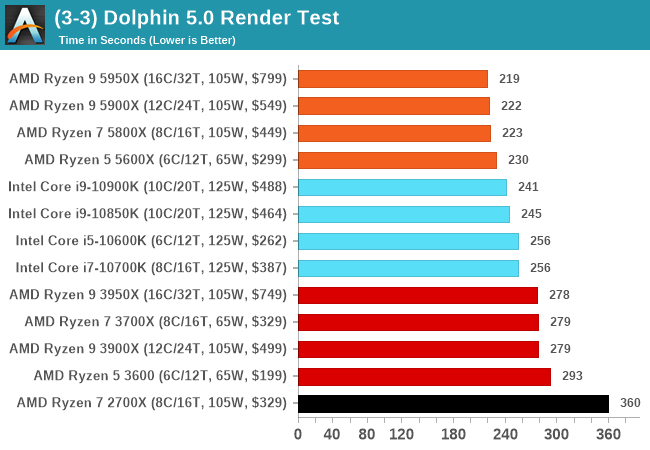












339 Comments
View All Comments
Qasar - Tuesday, November 10, 2020 - link
simple. if intel/nvidia does it, its ok, and accepted. but if amd does it ? its a crime, and becomes important.TheinsanegamerN - Thursday, November 12, 2020 - link
The leectrical costs from running intel VS amd add up to literal cents per month. If you are that concerned....you shouldnt be buying $500 CPUs.Cost of ownership really only matters, similarly, on cheap low end cars. People buying $100K+ mercedes are not particularly concerned about the price of parts or fuel, if they were they wouldnt be buying a $100K car.
Threska - Monday, November 16, 2020 - link
Funny thing my APC UPS keeps track of something like that for things plugged it. Only thing that demonstrates is that everything costs, even FUN.Spunjji - Sunday, November 8, 2020 - link
Only if you totally ignore performance per watt... You need a cooler capable of dissipating up to 250W to hit that performance, and even then, your characterisation here is garbage. Overall the 5800X is a superior product for the same price, and it's only just been released.Let the shitty, bitter takes continue!
Gigaplex - Thursday, November 5, 2020 - link
And when Intel held the performance crown, they priced their parts higher than the competition. This is to be expected. AMD only undercut on price because they couldn't compete on performance previously.LithiumFirefly - Friday, November 6, 2020 - link
They didn't just price their parts higher for nearly 25 years they just slapped $1,000 price tag on their top chip didn't matter what its performance was $1,000 that's what it was.just4U - Thursday, November 5, 2020 - link
the 5900X is nice at it's price point @ only 3-10 bucks more than the 10900K which appears to be what it's competing with.. and all the 10core parts really. The 5800X is in a odd position.. and I doubt it's going to be all that popular at that price point.Spunjji - Sunday, November 8, 2020 - link
5600 and 5700 non-X will be where it's at for value when they roll around.just4U - Monday, November 9, 2020 - link
Yeah I agree.. plus it's likely that prices will come down on these parts somewhat or be offered on sale or bundled..(saw a bit of that on launch day but they all sold out so whatever)bananaforscale - Monday, November 9, 2020 - link
"Value destroying price hike"? Sure for 3600 vs 5600X (which is *arguably* comparable), 3900X vs 5900X there's no contest. 5900X is demonstrably more than 10% faster is most cases. FWIW, I'd go for the 5800X over 10900K performance being equal because PCIe 4 and lower power draw.